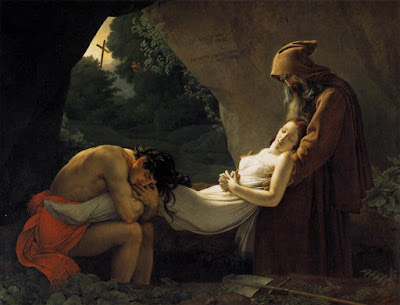 |
Anne-Louis Girodet
Study for Une Scène de Déluge
ca. 1806
drawing
Musée du Louvre |
 |
Anne-Louis Girodet
Une Scène de Déluge
1806
oil on canvas
Musée du Louvre |
 |
Anne-Louis Girodet
Study for The Entombment of Atala
(Chactas embracing Atala, from the novel by Chateaubriand)
ca. 1808
drawing
Musée du Louvre |
 |
Anne-Louis Girodet
Study for The Entombment of Atala
(Chactas embracing Atala, from the novel by Chateaubriand)
ca. 1808
drawing
Musée du Louvre |
 |
Anne-Louis Girodet
The Entombment of Atala
(Chactas embracing Atala, from the novel by Chateaubriand)
1808
oil on canvas
Musée du Louvre |
 |
Anne-Louis Girodet
Study for The Revolt of Cairo
ca. 1810
drawing (colored chalks)
Musée du Louvre |
 |
Anne-Louis Girodet
Study for The Revolt of Cairo
ca. 1810
drawing (colored chalks)
Musée du Louvre |
 |
Anne-Louis Girodet
Study for The Revolt of Cairo
ca. 1810
drawing (colored chalks)
Musée du Louvre |
 |
Anne-Louis Girodet
The Revolt of Cairo (21 October 1798)
1810
oil on canvas
Château de Versailles |
 |
Anne-Louis Girodet
Study for Napoleon in Coronation Robes
ca. 1812
drawing
Musée du Louvre |
 |
Anne-Louis Girodet
Study for Napoleon in Coronation Robes
ca. 1812
drawing
Musée du Louvre |
 |
Anne-Louis Girodet
Study for Napoleon in Coronation Robes
ca. 1812
drawing
Musée du Louvre |
 |
Anne-Louis Girodet
Napoleon in Coronation Robes
ca. 1812
oil on canvas
Bowes Museum, Barnard Castle, County Durham |
The French government commissioned Girodet to produce thirty-six identical copies of this coronation portrait, of which twenty-six were completed for distribution around Europe before times changed and the Napoleonic Empire ceased to exist. Girodet undoubtedly required a live model for the nude study-drawing above, but that model would certainly not have been Napoleon himself – the artist instead placed Napoleon's head on the body of a similarly compact but far more robust individual.
 |
Anne-Louis Girodet
Venus emerging from the Sea
ca. 1800-1810
drawing
Musée du Louvre |
 |
Anne-Louis Girodet
Self Portrait
ca. 1800
drawing
Musée du Louvre |
"When David, that icy star, rose above the horizon of art, with Guérin and Girodet (his historical satellites, who might be called the dialecticians of the party), a great revolution took place. Without analysing here the goal which they pursued; without endorsing its legitimacy or considering whether they did not overshoot it, let us state quite simply that they had a goal, a great goal which consisted in reaction against an excess of gay and charming frivolities, and which I want neither to appraise nor to define; further, that they fixed this goal steadfastly before their eyes, and that they marched by the light of their artificial sun with a frankness, a resolution and an esprit de corps worthy of true party-men. . . . I remember most distinctly the prodigious reverence which in the days of our childhood surrounded all those unintentionally fantastic figures, all those academic spectres – those elongated human freaks, those grave and lanky Adonises, those prudishly chaste and classically voluptuous women . . . believe me, I could not look at them without a kind of religious awe. And the whole of that truly extra-natural world was forever moving about, or rather posing, beneath a greenish light, a fantastic parody of the real sun. But these masters, who were once overpraised and today are over-scorned, had the great merit – if you will not concern yourself too much with their eccentric methods and system – of bringing back the taste for heroism into the French character. That endless contemplation of Greek and Roman history could not, after all, but have a salutary, Stoic influence; but they were not always quite so Greek and Roman as they wished to appear. David, it is true, never ceased to be heroic – David the inflexible, the despotic evangelist. But as for Guérin and Girodet, it would not be hard to find in them a few slight specks of corruption, one or two amusing and sinister symptoms of future Romanticism – so dedicated were they, like their prophet, to the spirit of melodrama."
– from The Exposition Universelle of 1855, published in Art in Paris, 1845-1862: Salons and Exhibitions reviewed by Charles Baudelaire, translated and edited by Jonathan Mayne (London: Phaidon Press, 1965)
 |
Anne-Louis Girodet
Study for The Dream of Aeneas
(Hector's ghost appearing to warn of Troy's fall)
ca. 1820
drawing
Musée du Louvre |
















Comments
Post a Comment